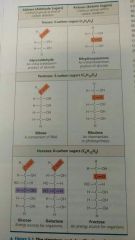![]()
![]()
![]()
Use LEFT and RIGHT arrow keys to navigate between flashcards;
Use UP and DOWN arrow keys to flip the card;
H to show hint;
A reads text to speech;
21 Cards in this Set
- Front
- Back
- 3rd side (hint)
|
Macromolecules |
4 classes of Large organic biological molecules: carbohydrates, lipids, proteins, and nucleic acids. |
|
|
|
Polymer |
Long molecule consisting of many similar or identical building blocks linked by covalent bonds. |
|
|
|
Monomer |
"Building block" molecules of a polymer. May have functions of their own. |
|
|
|
Enzymes |
Specialized macromolecules that speed up chemical reactions. |
|
|
|
Hydrolysis |
Chemical reaction that breaks bonds between two molecules by the addition of water; functions in disassembly of polymers to monomers. |
|
|
|
Dehydration reaction |
Reaction in which two molecules are covalently bonded to each other, with the loss of a water molecule. |
Way in which monomers are connected. |
|
|
Carbohydrates |
Includes sugars and polymers of sugars. Simplest are monosaccharides. |
|
|
|
Sugar chart |

|
|
|
|
Monosaccharides |
Simple sugars; simplest carbohydrate, active alone or serving as a monomer for disaccharides and polysaccharides. Molecular formulas: multiples of CH2 O |
|
|
|
Disaccharides |
Carbohydrates consisting of two monosaccharides joined by a glycosidic linkage* |
|
|
|
Glycosidic linkage |
Covalent bond formed between 2 monosaccharides by a dehydration reaction. |
|
|
|
Polysaccharides |
Macromolecules; polymers with a few hundred to a free thousand monosaccharides joined by glycosidic linkages. Serve as storage material or building material. |
|
|
|
Starch |
Storage polysaccharide in plants, consisting entirely of glucose monomers joined by alpha glycosidic linkages. |
|
|
|
Glycogen |
Extensively branched glucose storage polysaccharide found in liver and muscles of animals; the animal equivalent of starch. |
|
|
|
Cellulose |
Polysaccharide that is a major component of the tough walls that enclose plant cells. Most abundant organic compound on earth. |
|
|
|
Lipids |
Group of large biological molecules, including fats, phospholipids, and steroids, that mix poorly, if at all, with water. |
|
|
|
Fats |
Lipid constructed from two smaller molecules: glycerol (an alcohol with 3 carbons and 3 hydroxyl groups), and fatty acids. |
|
|
|
Fatty acid |
Carboxylic acid with a long carbon chain; Vary in length and in the # and location of double bonds; the fatty acids linked to to a glycerol molecule form a fat molecule (triacyglycerol or triglyceride). |
|
|
|
Saturated fatty acid |
Fatty acids in which all of the carbons in the hydrocarbon tail are connected by single bonds, maximizing the # of hydrogen atoms that are attached to the carbon skeleton. |
|
|
|
Unsaturated fatty acids |
Fatty acid that has one or more double bonds between carbons in the hydrocarbon tail. Such bonding reduces the # of hydrogen atoms attached to the carbon skeleton. |
|
|
|
Trans fats |
Unsaturated fatty, formed artificially during the hydrogenation of oils, containing one or more trans double bonds. |
|

